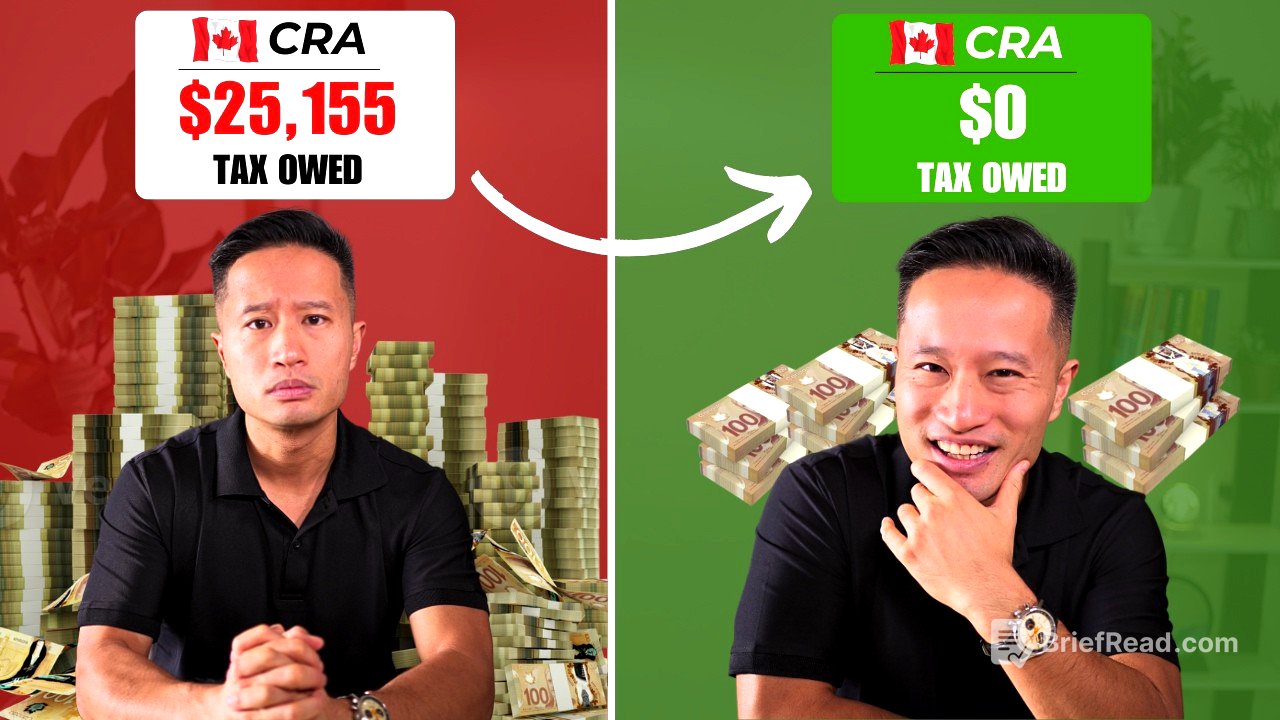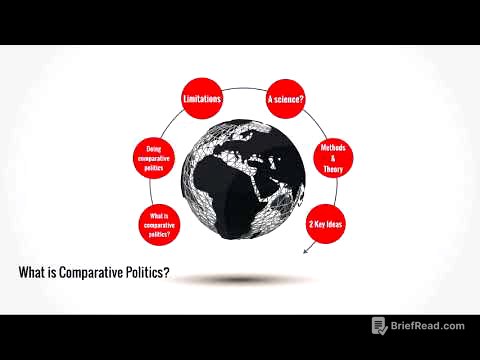TLDR;
This video provides a comprehensive guide to tax savings strategies for Canadians, focusing on investments, income splitting, deductions, retirement, and self-employment. Key strategies include utilizing registered accounts like TFSAs and RRSPs, income splitting through FHSA contributions and pension sharing, maximizing tax deductions and credits, optimizing retirement income through RRIF withdrawals and TFSA usage, and claiming business expenses for self-employed individuals.
- Utilize registered accounts like TFSAs and RRSPs for tax-advantaged growth.
- Implement income splitting strategies to balance taxable income between spouses.
- Maximize available tax deductions and credits to reduce your tax bill.
- Optimize retirement income through strategic withdrawals and tax credits.
- Claim all eligible business expenses if self-employed to lower taxable income.
Introduction [0:00]
The video introduces the concept of tax savings for Canadians, addressing the common frustration of high taxes. It outlines five key areas to focus on for maximizing tax savings: investments, income splitting, deductions and credits, retirement tax strategies, and self-employment tax planning. The video promises to guide viewers through these categories to help them keep more of their earnings.
Saving Money on Investments [0:33]
This section emphasizes the importance of registered accounts like TFSAs and RRSPs for investment. It illustrates the difference these accounts can make using an example of Mark, who invests in a TFSA, RRSP, and a non-registered account. The TFSA provides 45% more value, while the RRSP nearly doubles the value of the non-registered account due to tax-free or tax-deferred growth. The introduction of the FHSA as a powerful wealth-building tool for first-time home buyers is also mentioned.
1a) Registered Accounts [0:45]
This part of the video explains how registered accounts like TFSAs and RRSPs can significantly impact wealth accumulation over time. It uses the example of Mark, a 30-year-old with $30,000 to invest, splitting it evenly between a TFSA, RRSP, and a non-registered account. After 30 years, the tax-advantaged accounts (TFSA and RRSP) substantially outperform the non-registered account due to tax-free or tax-deferred growth.
1b) Tax Efficient Investment Choices for Each Account [2:24]
The video discusses how to optimize investment choices within different account types to minimize taxes and maximize returns. For TFSAs, it recommends avoiding U.S. dividend stocks and ETFs due to withholding taxes, suggesting Canadian or non-dividend paying international stocks instead. RRSPs are ideal for income-heavy assets like U.S. dividend stocks and ETFs, as there's no withholding tax. Non-registered accounts are best for investments with favorable tax treatment, such as Canadian dividend stocks benefiting from the dividend tax credit, or non-dividend paying stocks like Berkshire Hathaway, where growth comes from capital gains.
2. Pay Less Taxes by Income Splitting [3:56]
This section introduces income splitting as a strategy to balance income between spouses, allowing couples to take advantage of lower tax brackets and save money. It describes income splitting as shifting income from a higher-income partner to a lower-income partner to balance the tax load. Several methods for income splitting are discussed, including using an FHSA, splitting pension income, spousal RRSP contributions, CPP income splitting, and splitting capital losses.
2a) Using Your FHSA [4:17]
The video explains how the FHSA can be used for income splitting. The higher-income partner gifts money to the lower-income partner, who then contributes to their FHSA, gaining a tax deduction and tax-free investment growth. This strategy offers immediate tax savings, tax-free growth, and flexibility to roll the FHSA into an RRSP if not used for a home. It is most effective when the higher-income partner has already maxed out their registered accounts.
2b) Splitting Pension Income [5:09]
This part of the video discusses how shifting pension income to a lower-income spouse can balance taxable income and reduce household taxes. Before age 65, only defined benefit pension plans qualify, but after 65, defined contribution pension plans, RRIFs, and LIFs also qualify. By allocating a portion of pension income to a spouse in a lower tax bracket, the overall household tax burden can be reduced.
2c) Spousal RRSP Contributions [5:49]
Spousal RRSPs allow a higher-income partner to contribute to the lower-income spouse's RRSP, deferring taxes and balancing retirement income. The higher-income partner reduces their taxable income, and when the lower-income spouse withdraws the funds in retirement at a lower tax rate, the couple saves on taxes overall. It's important to avoid early withdrawals within 3 years of the contribution to prevent attribution back to the contributing spouse.
2d) CPP Income Splitting [6:18]
Couples receiving CPP benefits can split up to 50% of their benefits, which can lower their overall tax bill. By shifting a portion of CPP income to the spouse in a lower tax bracket, the couple can take advantage of lower tax rates and reduce their combined tax liability.
2e) Splitting Capital Losses [6:36]
This section explains how to offset one spouse's capital gains with the other's capital losses using superficial loss rules. This strategy applies to non-registered accounts and must comply with CRA rules for timing and holding periods. By offsetting capital gains with losses, couples can reduce their overall tax burden.
3. Maximizing Deductions and Tax Credits [7:13]
The video transitions to the third major category: maximizing deductions and tax credits. It describes deductions and tax credits as "hidden treasures" that directly reduce your tax bill or taxable income. Knowing which ones to claim can lead to significant savings.
3a) Childcare Expenses [7:31]
Eligible childcare expenses can be deducted, lowering taxable income. For children under 7, up to $8,000 per child can be claimed annually, and for children aged 7 to 16, up to $5,000 can be claimed.
3b) Moving Expenses [7:46]
If you relocate at least 40 km closer to a new job or school, you can deduct moving expenses. Eligible expenses include transportation, storage, and temporary living costs.
3c) Medical Expenses [8:03]
Medical expenses exceeding the lesser of 3% of your net income or a set threshold can be claimed. The video provides an example to illustrate how claiming medical expenses can result in tax savings.
4. Saving Taxes in Retirement [8:42]
This section focuses on tax strategies for retirement, emphasizing that tax planning doesn't stop once you retire. How you withdraw and manage your retirement income can significantly impact your overall taxes paid.
4a) RRIF Withdrawal Strategies to Minimize Taxable Income [8:57]
Mandatory RRIF withdrawals can push you into a higher tax bracket. Using your younger spouse's age to calculate RRIF minimums allows you to withdraw less each year, keeping taxable income lower for longer.
4b) Tax Credits for Retirees [9:23]
Retirees can lower their tax bills with credits like the age amount credit and the pension income credit. Canadians aged 65 or older can claim an additional amount as a non-refundable tax credit, though this credit phases out at higher income levels. Up to $2,000 of eligible pension income can be claimed, offering a federal tax credit of 15%.
4c) TFSA and RRSP Optimization in Retirement [10:18]
Strategic use of TFSAs and RRSPs in retirement can manage taxable income and preserve government benefits. TFSA withdrawals are tax-free, making them an ideal supplement to RRSP withdrawals to avoid higher tax brackets. Excess RRSP withdrawals can be shifted to your TFSA, reducing future RRIF withdrawals and providing tax-free growth.
4d) Using Life Insurance as a Tax Saving Tool [11:16]
Permanent life insurance policies, such as whole or universal life, offer tax-efficient ways to transfer wealth. Policyholders can grow investments within the policy tax-free and leave a tax-free death benefit to beneficiaries. This is especially effective because your entire estate is deemed disposed of upon passing, and shifting some RSP savings into a life insurance policy can transfer that value to beneficiaries tax-free.
5. Tax Strategies for Self-Employed Business Owners [12:16]
The video transitions to tax strategies for self-employed business owners, noting that self-employment offers unique tax-saving opportunities.
5a) Claiming Business Expenses [12:31]
Many business expenses are tax-deductible, including office supplies, marketing, business travel, and professional fees. Claiming these expenses can significantly reduce your taxable income.
5b) Home Office Deductions [13:03]
If you work from home, you can claim a percentage of your household expenses, like rent, utilities, and property taxes, based on the space used for business.
5c) Hire a family member [13:25]
If a spouse or family member helps with your business, you can pay them a reasonable salary for their contributions. This shifts income to someone in a lower tax bracket, saving your family money overall. It's crucial for the salary to be reasonable, as the CRA is strict on this rule.









